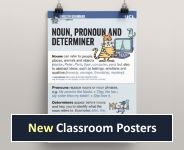Glossary
The Englicious Glossary includes the new National Curriculum glossary terms, which are shown against a white background. However, there's much more to be found here:
- we have added many entries that we feel are important, but cannot be found in the NC Glossary (e.g. connective), and
- in many cases we have added information to the (often very brief) NC entries that need further explanation (e.g. clause and phrase).
Please note that in line with our practice throughout the site, we use capital letters for function terms such as Subject, Direct Object, Indirect Object, Modifier, etc. Although this convention is not followed in the documentation published by the Department for Education we have also done so in the text that forms part of the National Curriculum Glossary.
Tip: Within our units and resources, Glossary items appear highlighted within the text. When you hover over them, or click on them in the Slideshow, a popup is generated.
verb
Verbs constitute one of the major word classes, including words for actions (e.g. shout, work, travel) and states (e.g. be, belong, remain). There are two main types of verb: main verbs and auxiliary verbs.
The surest way to identify verbs is by the ways they can be used: they can usually have a tense, either present tense or past tense (see also future).
- He lives in Birmingham. [present tense]
- The teacher wrote a song for the class. [past tense]
Verbs are sometimes called ‘doing words’ because many verbs name an action that someone does; while this can be a way of recognising verbs, it doesn’t distinguish verbs from nouns (which can also name actions). Moreover many verbs name states or feelings rather than actions.
- He likes chocolate. [present tense; not an action]
- He knew my father. [past tense; not an action]
Not verbs:
- The walk to Halina’s house will take an hour. [noun]
- All that surfing makes Morwenna so sleepy! [noun]
Verbs can be classified in various ways: for example, as auxiliary verbs, or modal verbs; as transitive verbs or intransitive verbs; and as states or events.
Irregular verbs form their past tense typically by a change of vowel (e.g. break-broke, see-saw, eat-ate). Be aware that in the National Curriculum a sequence of one or more auxiliaries together with a main verb are regarded as forms of the main verb. For example, have eaten is a form (the perfect form) of the verb eat, and will have been being seen is a form of the verb see. In other frameworks such sequences are regarded as verb phrases.
verb form
The forms a verb can take. For example, for be we have am, are, is, was, being, been; for walk we have walks, walked, walking, and for see we have sees, saw, seeing, and seen.
The National Curriculum also uses this term to include tense and aspect. In this sense there are six different ‘tense’ forms of a verb: the simple present tense and past tense forms, plus the present and past forms of the progressive and perfect.
- He lives in Birmingham. [simple present]
- He lived in Birmingham. [simple past]
- He is living in Birmingham. [present progressive]
- He was living in Birmingham. [past progressive]
- He has lived in Birmingham. [present perfect]
- He had lived in Birmingham. [past perfect]
verb phrase
In grammar studies the term verb phrase (VP) has been defined in different ways. On the Englicious website we mainly use the first definition.
1. A verb phrase is a phrase in which a lexical verb functions as the Head. The Head can occur alone or together with one or more auxiliary verbs:
In this conception of verb phrase the direct object and possible adjuncts are not included in the VP.
Note: The label 'verb phrase' is not used in the National Curriculum. The National Curriculum defines a clause as "a special type of phrase whose Head is a verb".
2. A verb phrase is a phrase in which a lexical verb functions as the Head; it can also contain elements other than verbs. In the sentence below the verb phrase comprises only the intransitive verb blush:
But in the next two sentences the VP consists of a verb and a following noun phrase taken together:
In these sentences the NPs function as Direct Object.
In addition to an Object a verb phrase may also contain an Adverbial:
See also clause.
vocal articulators
vocal tract
voice
voiced
vowel
A vowel is a speech sound which is produced without any closure or obstruction of the vocal tract.
Vowels can form syllables by themselves, or they may combine with consonants.
In the English writing system, the letters a, e, i, o, u and y can represent vowels.
The term 'vowel' is used in two ways: first, for a sound which is made with the mouth fairly open and which forms the central part of a syllable; and second, for a letter which is used to write a vowel sound, e.g. a, e, i, o, u. See also the contrasting term consonant.

